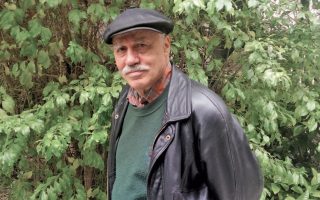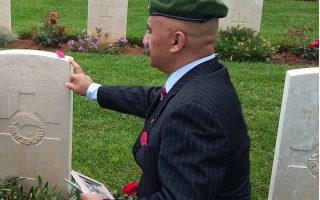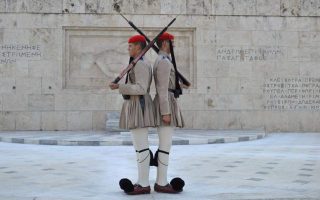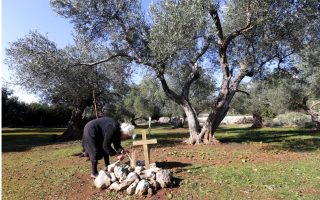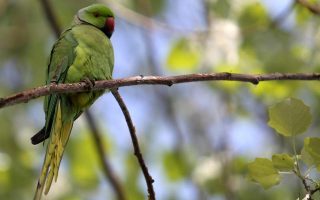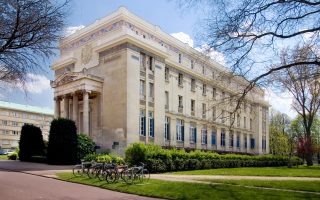The Jews of Halkida
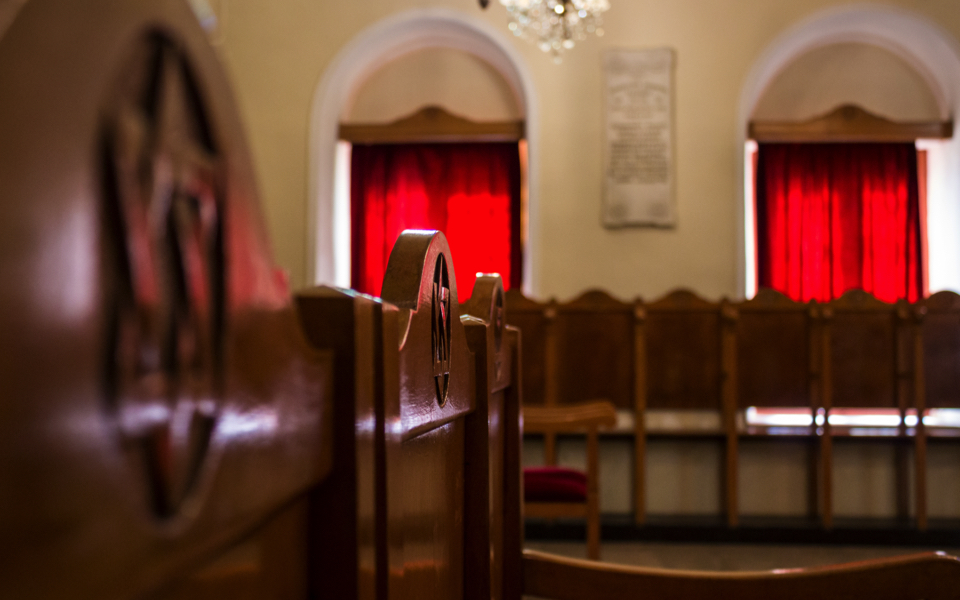
“When we returned, we had no bed to sleep in, no pots to cook in, nor clothes to wear. We went to our house and it had been taken by others. We rented a room in our house and the whole family lived there.”
Mair Maissis is in the synagogue of Halkida (Chalcis), eager to serve as a guide for anyone who wants to learn more about the town’s Jewish community and cemetery. Willing and full of energy, he starts explaining the architecture of the Romaniote synagogue.
“The two columns of our synagogue prove its antiquity. A large number of scholars regard the Synagogue of Chalcis as the oldest in Europe and many believe that the first presence of Jews in Evia (Euboea) dates back to 586 BC. Around the synagogue was the Jewish ghetto, the Jewish quarter where most Jews lived until the end of the Ottoman domination.
“On Good Friday in 1854, a great fire broke out which destroyed the biggest part of the synagogue. Of course it was arson. Nearly all community archives, books, heirlooms and manuscripts were destroyed. Only three Torah scrolls dating to the 13th and 14th century have survived until today. The synagogue was rebuilt in 1855 with a donation from the Duchess of Plaisance [Doukissa tis Plakentias]. Luckily today, we do not have any anti-Semitic incidents here in our city. We are completely assimilated.”
The families
“We came from Italy. We were doing business with cornflakes, and in Italian ‘mais’ means corn. So we were named after the profession. We left when the persecutions of Ferdinand and Isabella began. We crossed to the city of Patras, then Mystras and finally Chalcis. At that time, we were traveling in enormous groups. They did not leave each other back.”
With the annexation of Thessaly to the newly established Greek state, some Jews in Halkida moved to Volos. There, they found a new dynamic community. Maissis’s mother came from this community. “My mother was Sephardi and she spoke Ladino. Of course, at our house in Halkida we only spoke Greek, neither Ladino nor Hebrew.”
Maissis was born in 1935, a few years before the great disaster. His father Solomon was a merchant, like most Jews at that time. “Then the community consisted of about 300 people. All merchants, spinners, craftsmen etc. The weekly market in Kriezotou Street was 90 percent Jewish.”
When the war broke out, he had only been able to go to school for a few weeks. The Jewish community had its own Jewish school where students were taught all the usual lessons along with the Hebrew language and the Jewish religion. “We were only able to learn about two or three songs and some scribbles.”
The partisans
“We were almost all saved. With the help of the partisans and of the local Bishop Gregory. Without them we would have followed the others. The bishop saved Jews who had been imprisoned and hid the sacraments of the synagogue.”
The partisans mobilized the Jewish families to leave Halkida and go to the mountains. They were hidden in villages such as Steni and Gides.
“We left before the German invasion. We had already learned of the incidents in Thessaloniki and Athens, and there was no possibility of us following the same fate. The partisans told us to pick up our things and we went up to the mountains with horses. We were hidden in Steni like many other Jews, although this was extremely dangerous. There we stayed in Christian homes. But we knew these Christians. They had been our customers for so many years.”
Even the Italian commander urged them to leave as soon as possible. On March 24, 1944, the Germans announced that all the Jews should gather in the synagogue to give them flour for Passover. They opened the door and they only saw the rabbi.
“They believed we would follow the rabbi and stay there. But we had chosen to mobilize and save ourselves.”
Twenty-two Jews were lost from the Halkida community. But how did this happen?
“Mainly German traitors,” Lili Kosti told me.
“So they captured my father and his sister. My father stayed in Halkida to look after his parents, who could not move. A Nazi partner betrayed him and caught him immediately. His sister came down from the mountain to take him and so she was caught. We could not leave our families.”
Who were the traitors? I asked her to describe them to me without telling me the names.
“Everything is now publicly available. I can tell you the name if you want. But do not imagine that the traitors and their associates were reputable individuals, educated and with families. They were just criminals.”
I asked if Jews joined the guerrillas.
“Of course, haven’t you heard about Sarica?” I had never heard of her.
“A 17-and-a-half-year-old girl. Sarah, or Sarica Geoshoua. When she first joined the guerrillas she helped with chores. She slowly became a leading figure and spread the word in the villages to get everyone to join the guerrillas. She focused on girls and after a while she got her own team of 12 young partisans.”
After the end of the occupation, during the civil war, Sarica was led before the prosecutor. She told the prosecutor: “I am not with either communists or the right. I went up there to fight the Germans.” The prosecutor released her on the condition that she left Greece for ever. She left for Israel and never returned to Greece.
After the occupation
“When we returned, we had no bed to sleep in, no pots to cook in, nor clothes to wear. We went to our house and it had been taken by others. We rented a room in our house and the whole family lived there,” said Maissis.
The first help came from America: clothes, beds, kitchen utensils, books for children.
“Many left for Athens, others for Thessaloniki because they thought they would find opportunities there. Others fled for Israel. As early as 1944, 160 of our people had left for Israel. We then had a Halkida lawyer, Sotiris Papastratis. He organized the mission for Israel. Free spirit, democrat. Later, he was honored with the Yad Vashem Prize for the Righteous Among the Nations.”
His family had nothing when he returned from the mountain to Halkida.
“We went with my father to Athens to get some goods and start over again. As soon as he entered the shop and the merchant saw him, he shouted: ‘Solomon lives! Give him whatever he wants.’ There was a great relationship of trust between us.”
The community saw a significant reduction in its numbers. The Jewish school ceased to open every day and the rabbi stopped in the early 1960s.
The current community
“Today we number about 50-60 people. All older in age and we only have a couple of children. Of course we keep all traditions and customs. We do it as we did before.”
When does the synagogue come to life?
“Every Friday we normally do our Shabbat service. We total about 20-25 people. For the needs of the service we have a hazzan – that is a cantor.
“But for the great feasts – Rosh Hashanah, Pesach (Passover) and Yom Kippur – we bring a rabbi.”
Entering the synagogue, a bookshelf caught my eye. Maissis writes about the history of the Jewish community and the synagogue and in a few days will present his second book, titled “The History of the Jewish Community of Halkida from 580 BC until 2001: The Cemetery.”
“Do tourists and people visit the place in order to learn more about the Jewish community?” I asked.
“In recent years we have had a lot of visitors. This month, you are the fourth who has come to learn. Not just tourists. Many locals come too.”
He prepares to lock up the synagogue and we go to the door to say goodbye.
“This year, on International Holocaust Remembrance Day on January 27, I went to talk to seven schools. Halls were filled with 350-400 children. They were hearing about all this for the first time. Teachers are now mobilized. If nothing is done through education and school, nothing can be done.”
Georgia N. Gleoudi is a research associate at the Lambrakis Foundation.
